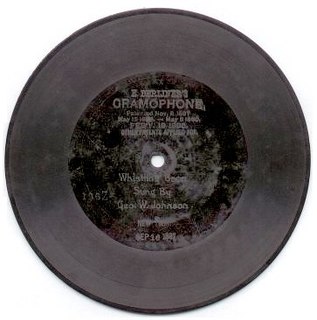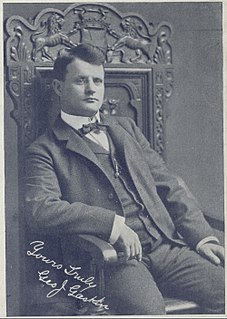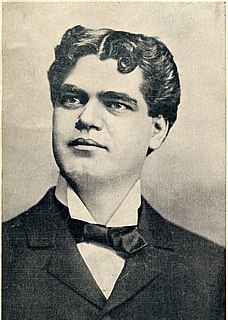Events in the year 1899 in music.

The Victor Talking Machine Company was an American recording company and phonograph manufacturer headquartered in Camden, New Jersey. It was the largest and most prestigious firm of its kind in the world, perhaps best known for its use of the famous "His Master's Voice" trademark and the production, marketing and design of the "Victrola" line of phonographs. Victor was purchased by the Radio Corporation of America in 1929, which continued with the manufacture of phonographs, records, radios and other products. Victor is the corporate ancestor to RCA Records.

Berliner Gramophone – its discs identified with an etched-in "E. Berliner's Gramophone" as the logo – was the first disc record label in the world. Its records were played on Emile Berliner's invention, the Gramophone, which competed with the wax cylinder–playing phonographs that were more common in the 1890s.

Emile Berliner originally Emil Berliner, was a German-American inventor. He is best known for inventing the lateral-cut flat disc record used with a gramophone. He founded the United States Gramophone Company in 1894; The Gramophone Company in London, England, in 1897; Deutsche Grammophon in Hanover, Germany, in 1898; and Berliner Gram-o-phone Company of Canada in Montreal in 1899.
The Gramophone Company Limited , based in the United Kingdom and founded on behalf of Emil Berliner, was one of the early recording companies, the parent organisation for the His Master's Voice (HMV) label, and the European affiliate of the American Victor Talking Machine Company. Although the company merged with the Columbia Graphophone Company in 1931 to form Electric and Musical Industries Limited (EMI), its name "The Gramophone Company Limited" continued in the UK into the 1970s.

George Washington Johnson was an American singer and pioneer sound recording artist, the first African-American recording star of the phonograph.

Frederick William Gaisberg was an American musician, recording engineer and one of the earliest classical music producers for the gramophone. He himself did not use the term 'producer', and was not an impresario like his protégé Walter Legge of EMI or an innovator like John Culshaw of Decca. Gaisberg concentrated on talent-scouting and persuading performers to make recordings for the newly invented Gramophone.

The Graphophone was the name and trademark of an improved version of the phonograph. It was invented at the Volta Laboratory established by Alexander Graham Bell in Washington, D.C., United States.

George J. Gaskin was one of the most popular singers in the United States during the 1890s and an early American recording artist.

Leonard Garfield Spencer was an early American recording artist. He began recording for the Columbia Phonograph Company, in 1889 or 1890. Between 1892 and 1897 he recorded extensively for the New Jersey Phonograph Company and its successor the United States Phonograph Company. He specialized in vaudeville sketches and comic songs, but also sang sentimental ballads popular at the time. He returned to Columbia in 1898 for an exclusive contract then began recording for Berliner Gramophone (disc) records in 1899 and continued with Victor and Columbia as discs became the dominant format in the early 1900s.

Fay Templeton was an American actress, singer, songwriter, and comedian.

Eldridge Reeves Johnson was an American businessman and engineer who founded the Victor Talking Machine Company in 1901 and built it into the leading American producer of phonographs and phonograph records and one of the leading phonograph companies in the world at the time. Victor was the corporate predecessor of RCA Records.

Daniel William Quinn was one of the first American singers to become popular in the new medium of recorded music. Quinn was a very successful recording artist whose career spanned from 1892 to 1918. Quinn recorded many of his hits in the legendary Tin Pan Alley of New York City.

The Volta Laboratory and the Volta Bureau were created in Georgetown, Washington, D.C. by Alexander Graham Bell.(19/20th-century scientist and inventor best known for his work on the telephone)

William F. Denny was an American vaudeville performer and pioneer recording artist.

John Yorke AtLee (1853–1933) was a pioneer recording artist in the 1890s in the United States.

Alfred Clark was a British-American pioneer of music recording and cinema. As a cameraman and director of productions at Edison's first studio, he was the first to make moving pictures with innovations like continuity, plot, trained actors and special effects. In 1896, he joined Emile Berliner's Gramophone Company and then went to Europe where he became an important manager of companies like HMV and EMI. He was naturalized as a British citizen in 1928 and he became a leading member of the Oriental Ceramic Society in London, establishing a valuable collection including rare pieces which had been made for the emperors of the Tang and Song dynasty.

Charles Adam Asbury was an American banjo player and pioneer recording artist active from 1876 to 1897. On the stage, he played parts that emphasized his multiracial ancestry, and his recording work was largely in the minstrel tradition. His surviving recordings are the earliest examples of the stroke style of banjo.

Roger Harding was an Irish-American singer, composer and music publisher active in the United States from 1890 to 1901.

David Cornelius Bangs was an American recording artist of the 1890s specializing in recitations.


















